

Noise Reduction in Hospitals: A remedy for all ills. Employee Communication tips for improved awareness. SnapComms is a workplace solution comprised of a visually vibrant suite of interactive employee communication tools that creatively convey messages directly to healthcare employee workstation computer screens.
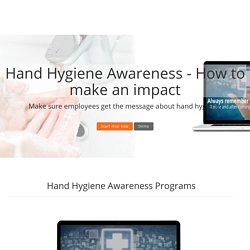
Desktop Scrolling News Feeds that deliver the latest hand hygiene messages and include key messages from CEOs or other institutional influencers. SnapComms’ desktop employee quiz tools enable healthcare providers to easily push questionnaires, tests, and various other messages to staff computers. Hand hygiene education quizzes, for example, can display instantly in an appealing format with increased participation and “pass” rates being driven through automatic pop up reminders. Unlike static messaging systems such as corporate email, internal communication software like SnapComms is more compelling, dynamic, and interactive and therefore, gets much better cut through.
Managing Cyber Risk in Health Care. When Anthem, the second largest insurance provider in the United States, revealed recently that its records had been compromised by hackers — resulting in the possible leaking of personal data of more than 80 million present and former customers — the incident became a much-needed wake-up call for the health care industry.

Unfortunately, Anthem is not the first company to experience a major data breach in the past 18 months. In 2014 alone, customer data, credit card information and intellectual property were stolen from Target, Home Depot, JPMorgan Chase, Sony Pictures and many others. What recent history has taught us is that hackers are becoming more sophisticated, attacks are becoming more malicious and no industry or organization is invulnerable. The public has moved on from asking, “How did this happen?”
6 Internal Tactics to Begin Your Community Hospital's Re-branding Campaign - Creative Triage Creative Triage. To effectively combat out-migration, community hospitals must reposition themselves from the inside out.
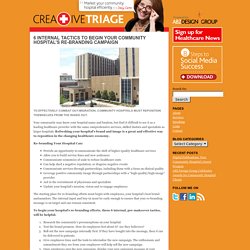
Your community may know your hospital name and location, but find it difficult to see it as a leading healthcare provider with the same comprehensive services, skilled doctors and specialists as larger hospitals. HealthTechZone - Healthcare Technology. Exclusive Article : Internal Communication not EHR to Blame. Exclusive Article at EMRIndustry.com by Jeff Riggins There has been quite a bit of finger pointing surrounding the chain of events that led to Eric Duncan’s release from Texas Health Presbyterian Hospital in Dallas.
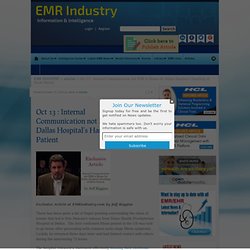
The first confirmed Ebola patient in the US was told to go home after presenting with common early stage Ebola symptoms. Luckily, he returned three days later and had limited contact with others during the intervening 72 hours. The hospital released a statement effectively blaming their electronic health record system. The hospital then backtracked and admitted that the EHR was not responsible and rather the clinicians who came in direct contact with the patient did not act on the data collected concerning his recent travel history. The common element in both narratives is a breakdown in communication.
Could the EHR have been designed better? Questions like these come to mind: Did the nurse assume the physician could see the data she/he entered into the chart? Education4betterhealth. Cindy Carson, National Director Communication: We’ve been talking a lot lately about communication here at Milner-Fenwick.
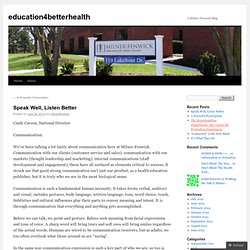
Communication with our clients (customer service and sales); communication with our markets (thought leadership and marketing); internal communications (staff development and engagement), these have all surfaced as elements critical to success. It struck me that good strong communication isn’t just our product, as a health education publisher, but it is truly who we are in the most biological sense. The Google Approach: How Hospitals Can Create Cultures That Drive Employee Engagement, Satisfaction. Industry experts say a deliberate, data-driven approach to employee engagement and satisfactions benefits hospitals, their staff members and their patients.
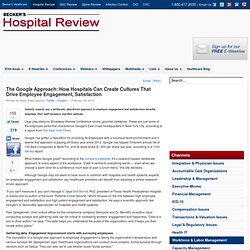
Lego play stations, Broadway-themed conference rooms, gourmet cafeterias. These are just some of the employee perks that characterize Google's East Coast headquarters in New York City, according to a report from The New York Times. 3 ways to drive employee engagement with data. Health systems and hospitals can learn a lot from Google's use of data to create an organizational culture that drives employee engagement and satisfaction, according to a Becker's Hospital Review article.
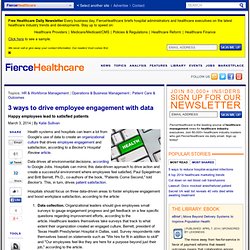
Data drives all environmental decisions, according to Google Jobs. Hospitals can mimic this data-driven approach to drive action and create a successful environment where employees feel satisfied, Paul Spiegelman and Britt Berrett, Ph.D., co-authors of the book, "Patients Come Second," told Becker's. This, in turn, drives patient satisfaction.
MassMedia Healthcare Marketing Blog » Tips on Improving Internal Communication. Employees are the lifeblood of any hospital or medical practice.
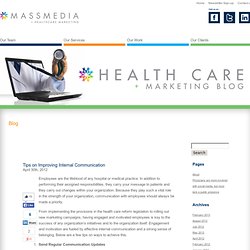
In addition to performing their assigned responsibilities, they carry your message to patients and they carry out changes within your organization. Because they play such a vital role in the strength of your organization, communication with employees should always be made a priority. From implementing the provisions in the health care reform legislation to rolling out new marketing campaigns, having engaged and motivated employees is key to the success of any organization’s initiatives and to the organization itself.
Engagement and motivation are fueled by effective internal communication and a strong sense of belonging. Create a Patient-Centered Culture. Zappos delivers great customer service, but its leader seems to talk mostly about his corporate culture.
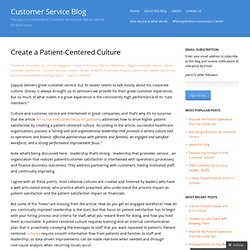
Disney is always brought up in seminars we provide for their great customer experience, but so much of what makes it a great experience is the consistently high performance of its “cast members.”